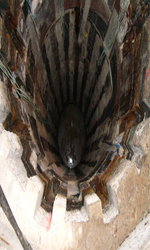Work package 5: Undisturbed host rock formations
For more information, please contact Geert Volckaert, (WP5) leader.
The main objectives of this WP are:
- To establish the conditions under which the different gas migration processes are dominant
- To identify how those processes can be modelled and to determine the values of the main parameters
- To measure the parameters that may have an impact on the long-term safety as a consequence of enhanced radionuclide transport through the host rock
Gas generation and migration may have an impact on the hydraulic and the mechanical properties of the host rock. Consequently, these processes could affect the safety function of the host rock to retard and spread in time the release of radionuclides.
Earlier studies have shown that the ratio between the gas generation rate and the diffusive gas flux through the undisturbed host rock determines the development of a separate gas phase as well as the rate of increase of gas pressure. The two-phase flow properties of the host rock will determine the gas pressure at which gas flow will start as well as the quantity of water that will be displaced. The latter is particularly important in case of MLW disposal where gas generation and radionuclide release in the near-field can occur at the same time. There is now a general consensus that in the case of plastic clay-rich clays and in particular bentonite, classic concepts of porous medium two-phase flow are inappropriate and continuum approaches to modelling gas flow may be questionable depending on the scale of the processes and resolution of the numerical model. The mechanisms controlling gas entry, flow and pathway sealing in general clay-rich media are not yet fully understood. The 'memory' of dilatant pathways within a clay could impair barrier performance.

